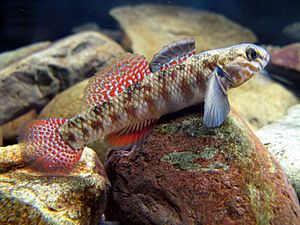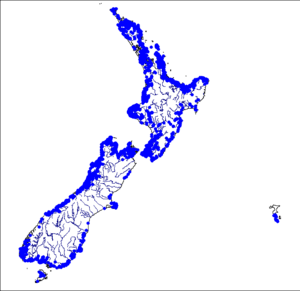Redfin bully facts for kids
Quick facts for kids Redfin bully |
|
|---|---|
 |
|
| Male redfin bully | |
| Conservation status | |
| Scientific classification | |
 |
|
| Range of Gobiomorphus huttoni | |
| Synonyms | |
|
The redfin bully (Gobiomorphus huttoni) is a type of freshwater fish found only in New Zealand. It belongs to the Eleotridae family. These fish are special because they spend part of their lives in the sea and part in fresh water.
Male redfin bullies are easy to spot. They have bright red patterns and stripes on their fins. Adult redfin bullies usually grow to be about 8 to 10 centimeters (3 to 4 inches) long. The biggest ones can reach up to 12 centimeters (about 4.7 inches).
Contents
What Does It Look Like?
Male redfin bullies are known for being the most colorful freshwater fish in New Zealand. They have bright red marks on their top, bottom, and tail fins. You can also see red on their bodies and cheeks.
Males also have a cool bluish-green stripe on the outer edge of their first top fin. Only the males have this red coloring. Females have the same patterns, but their colors are brown instead of red.
Both male and female redfin bullies have special diagonal stripes on their cheeks. These stripes are very helpful for telling them apart from other fish. You can even see them on small fish, about 3 centimeters (1.2 inches) long, and on very pale ones. Males tend to be larger than females.
Where Do Redfin Bullies Live?
Redfin bullies are found only in New Zealand. They live all over the two main islands, and also on Stewart Island and the Chatham Islands.
They are not very common along the east coast of the South Island, except around Banks Peninsula. Redfin bullies are amazing climbers. They can even climb up waterfalls to move upstream! They prefer to live close to the coast. You won't find them living in lakes or ponds that are completely cut off from the sea.
These fish mostly live in small streams that have lots of rocks and boulders. They like places where the water flows at a medium speed, with both calm pools and fast-moving riffles. They prefer streams with large gravel and cobble (round stones) on the bottom. While they don't need a lot of shade, they do like streams surrounded by native trees.
Life Cycle
Redfin bullies have a unique life cycle. They are called "amphidromous" fish. This means they travel between fresh water and the sea as they grow.
During winter and spring, the male redfin bully finds a good spot for a nest. This is usually a hollow space under a rock. The male will guard this nest very carefully. When he is protecting the nest, his color changes from brown to a very dark black.
When a female is ready to lay her eggs, she swims into the nest. She turns upside down to lay her eggs. She lays between 1,000 and 20,000 oval-shaped eggs. They stick together in a single layer on the "ceiling" of the nest. After she lays the eggs, the male fertilizes them.
The female then leaves, and the male stays to guard the eggs. He protects them until they hatch, which takes about two to four weeks. A female might lay eggs more than once during the spawning season. Also, one male might guard the eggs from several different females.
When the tiny fish hatch, they are only about 3 millimeters (0.1 inches) long. They are carried downstream by the water to the sea. They spend several months growing in the ocean. Then, when they are about 1.5 to 2 centimeters (0.6 to 0.8 inches) long, they swim back to fresh water. They will live the rest of their lives in streams.
Redfin bullies seem to need to spend their first few months in the sea. This is because no groups of them have ever been found living only in fresh water, completely cut off from the ocean. Young redfin bullies are the best climbers among their fish relatives. They are mostly found in streams closer to the coast. They become old enough to have their own babies when they are two years old. On average, they live for about 3 to 4 years.
What Do Redfin Bullies Eat?
Redfin bullies are not picky eaters. They eat whatever food they can find. Their diet includes:
- Larvae (young forms) of chironomid midges
- Larvae of mayflies
- Larvae of caddisflies
- Small crustaceans (like tiny shrimp)
- Aquatic snails
Threats to Redfin Bullies
The redfin bully faces a few main dangers. One big threat is competition and being eaten by introduced fish, especially brown trout (Salmo trutta). These trout were brought to New Zealand and can compete for food or prey on young bullies.
Another threat is the loss of their natural homes. This happens when streams are damaged or changed by human activities. Over the last ten years, the number of redfin bullies has gone down by 20%. Because of this, they are now considered a "near-threatened" species. This means they could become endangered if their numbers keep dropping.


